Abstract
Water-washed Serratia marcescens (ATCC strain 14041) cells were lyophilized in an all-glass system capable of evacuation to pressures of less than 5 × 10-6 torr. Lyophilization at the lowest pressures resulted in 50 to 65% survival for unstabilized washed organisms compared with 10 to 20% when the cells were lyophilized at pressures of about 2.5 × 10-2 torr. At the latter pressures, 45 to 65% survival was obtained when NaCl or Naylor-Smith stabilizer was added to the cell suspensions before lyophilization. However, the stabilizers failed to increase significantly the levels of survival compared with water suspension when cells were lyophilized at pressures less than 10-5 torr. The high survival rates obtained by the high-vacuum technique may be attributed to the reduction of traces of molecular oxygen which has been reported to be destructive of the dried bacteria. Survival of unstabilized dried S. marcescens after 1-day storage increased markedly with decreasing sealing pressure. Under the highest vacuum attained, survival of the dried bacteria was not impaired by storage for up to 1 month at Dry Ice temperatures; at higher temperatures, viability losses occurred. Exposure of the dried unstabilized bacteria to dry air resulted in rapid viability loss. The inactivation could be stopped almost immediately by evacuation to pressures of less than 10-5 torr, but the evacuation failed to reverse the viability losses that occurred during exposure.
Full text
PDF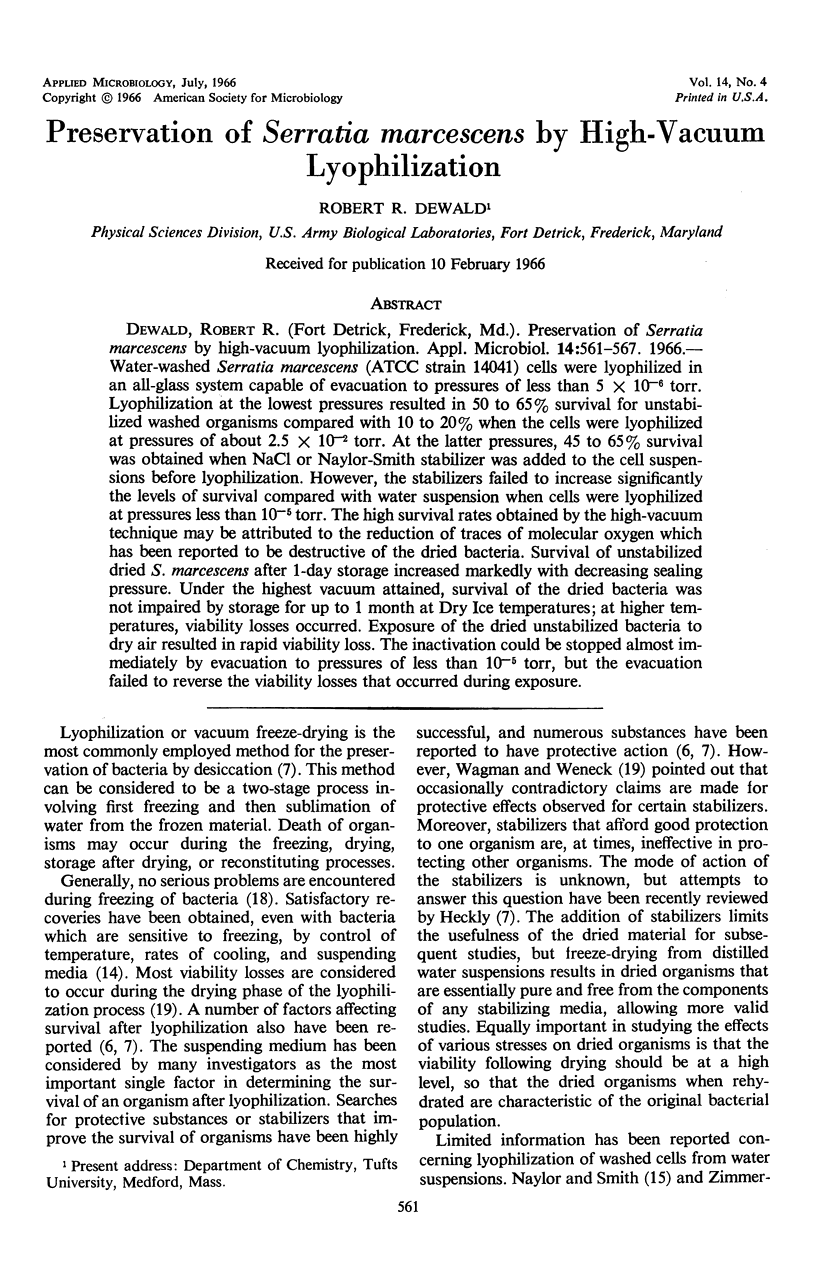
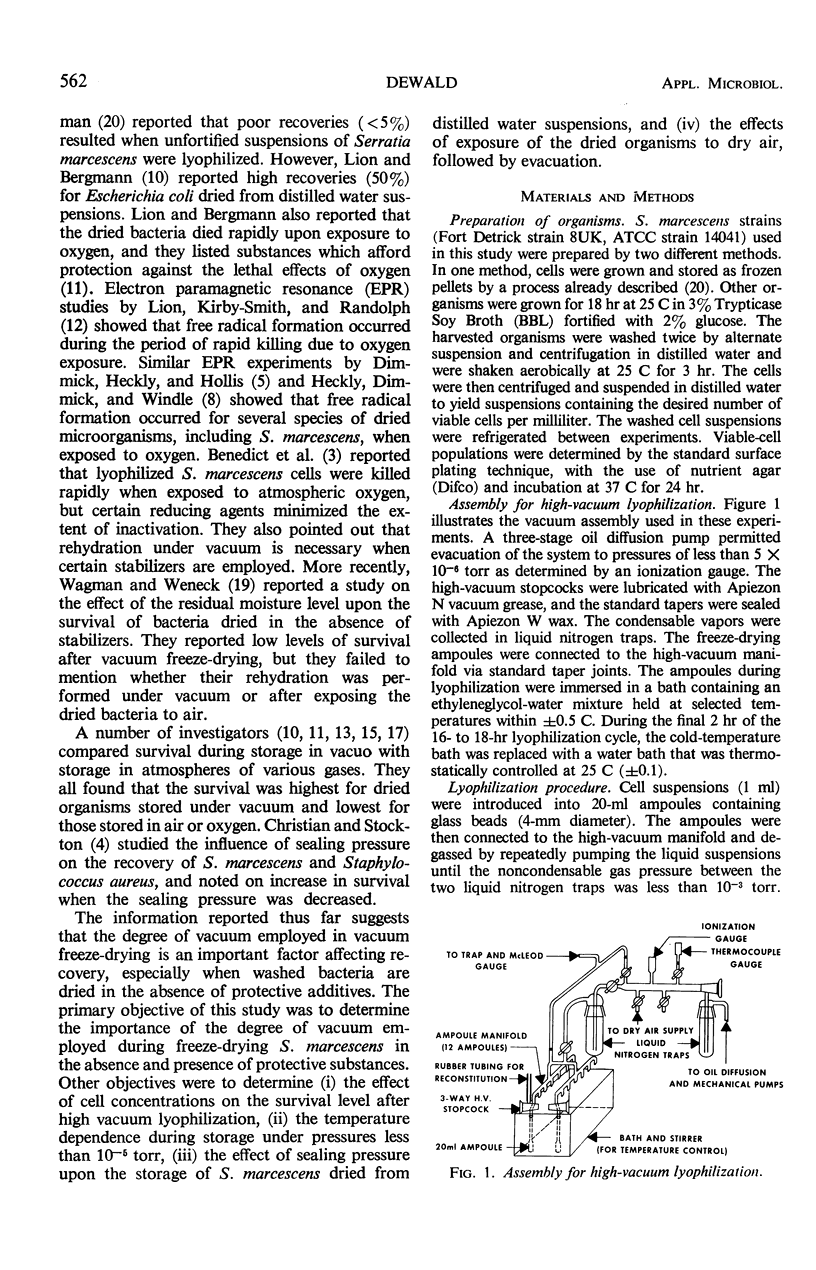
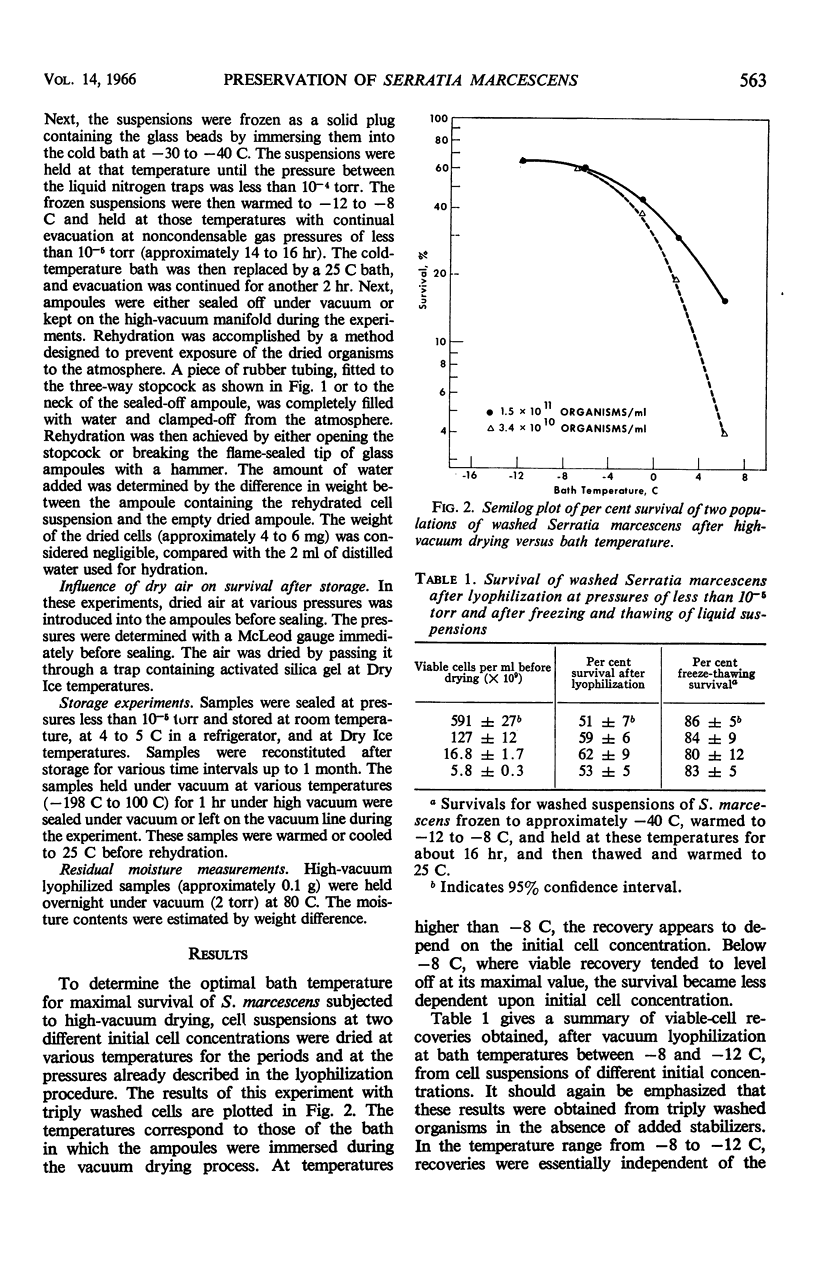
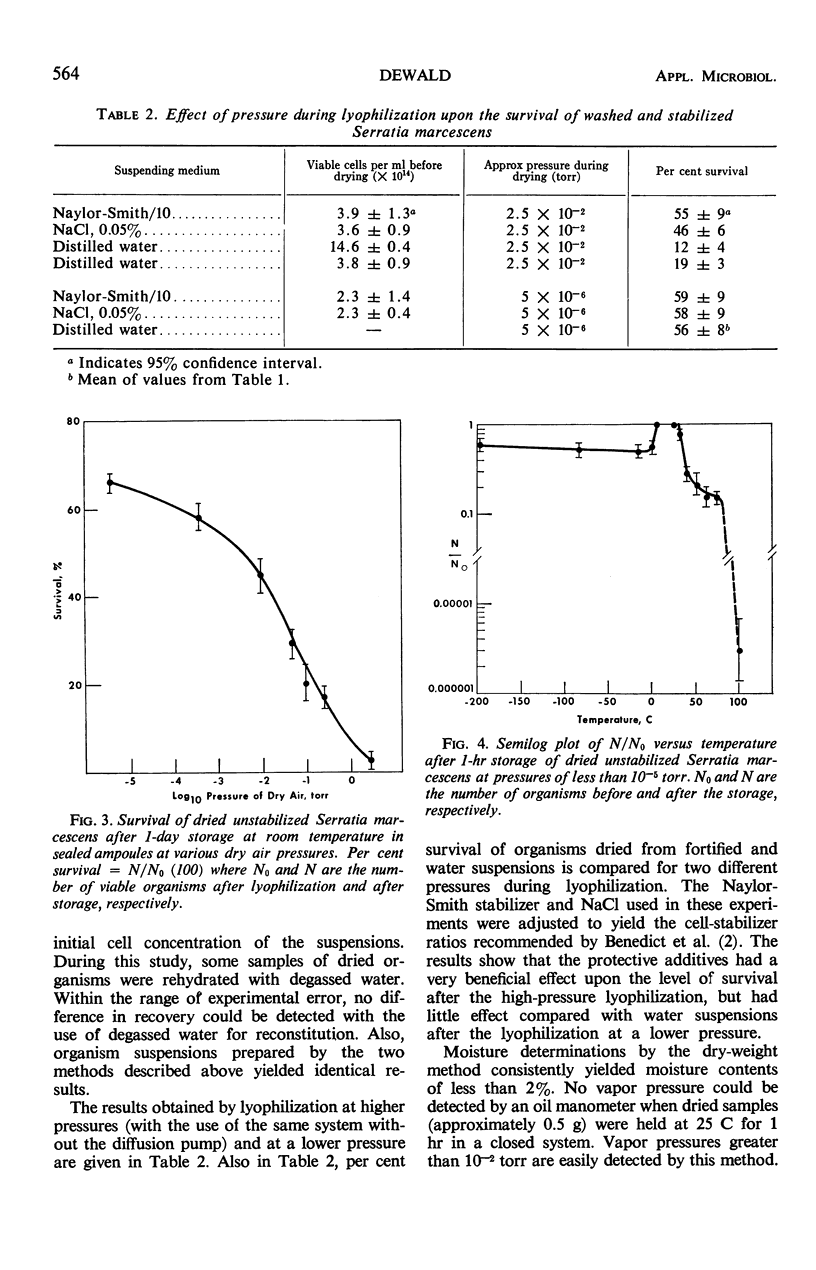
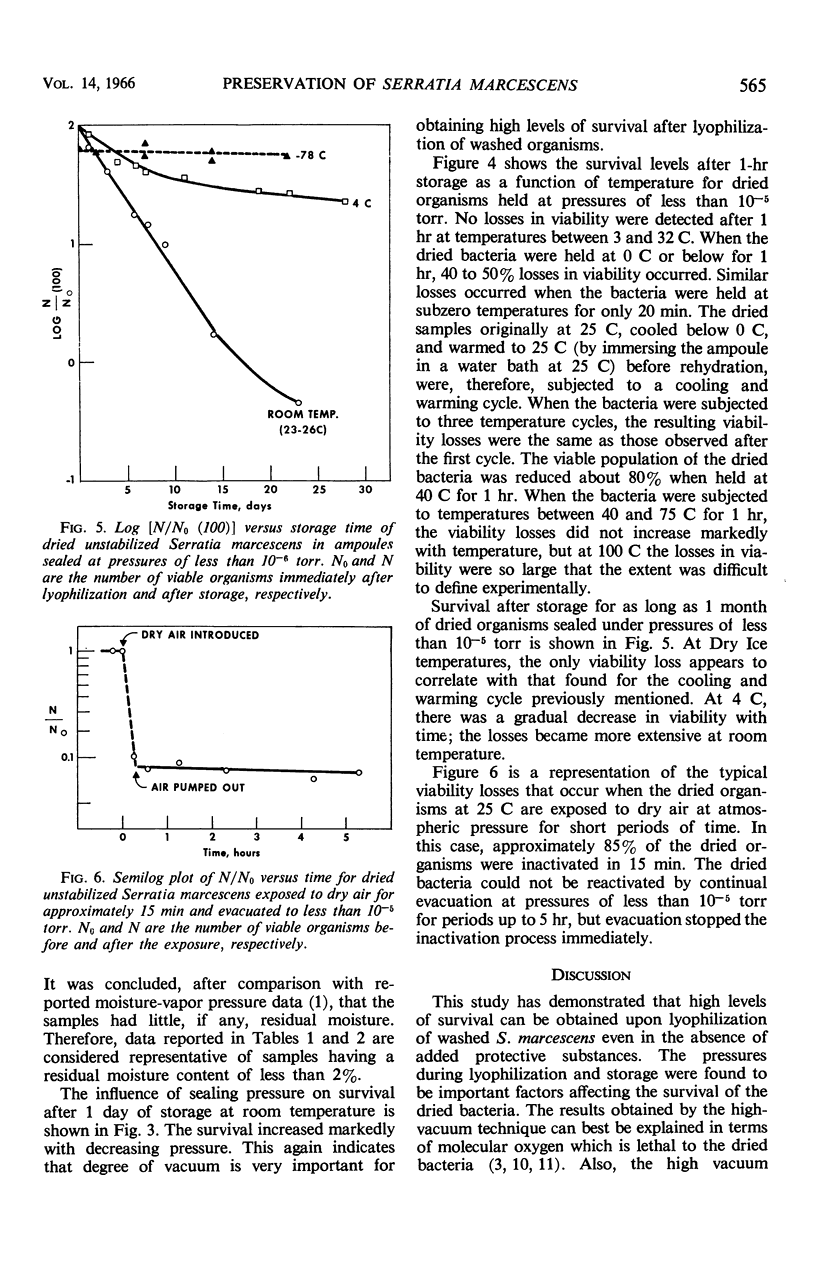
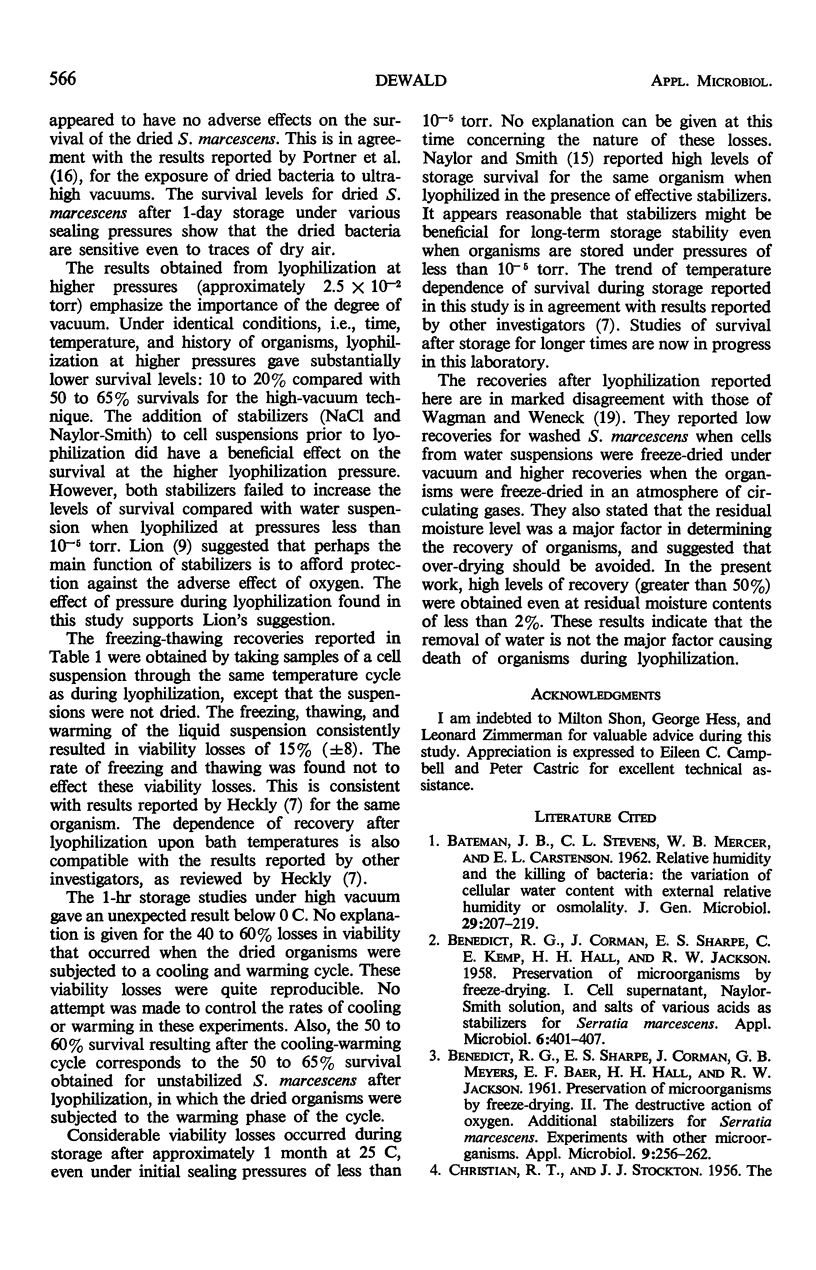
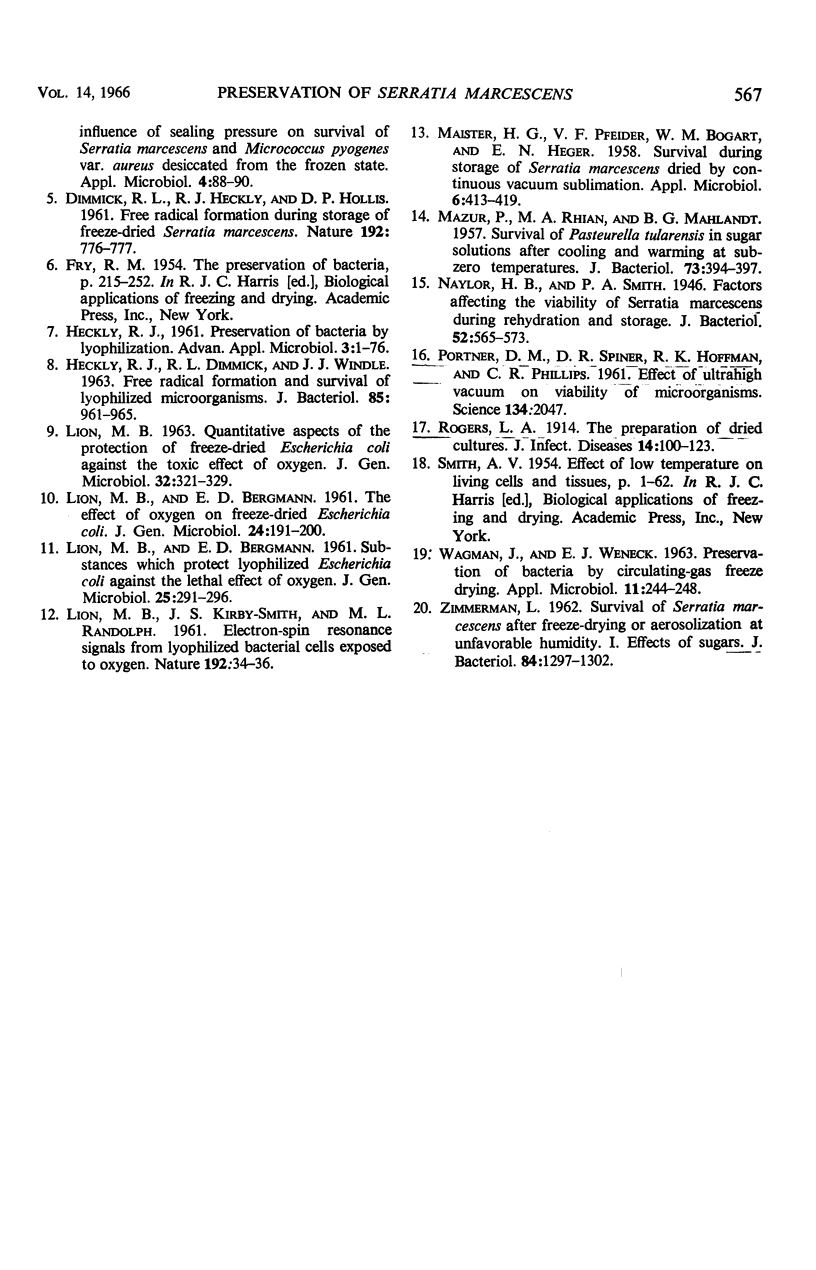
Selected References
These references are in PubMed. This may not be the complete list of references from this article.
- BATEMAN J. B., STEVENS C. L., MERCER W. B., CARSTENSEN E. L. Relative humidity and the killing of bacteria: the variation of cellular water content with external relative humidity or osmolality. J Gen Microbiol. 1962 Oct;29:207–219. doi: 10.1099/00221287-29-2-207. [DOI] [PubMed] [Google Scholar]
- BENEDICT R. G., CORMAN J., SHARPE E. S., KEMP C. E., HALL H. H., JACKSON R. W. Preservation of microorganisms by freeze-drying. I. Cell supernatant, Naylor-Smith solution, and salts of various acids as stabilizers for Serratia marcescens. Appl Microbiol. 1958 Nov;6(6):401–407. doi: 10.1128/am.6.6.401-407.1958. [DOI] [PMC free article] [PubMed] [Google Scholar]
- Benedict R. G., Sharpe E. S., Corman J., Meyers G. B., Baer E. F., Hall H. H., Jackson R. W. Preservation of Microorganisms by Freeze-drying: II. The Destructive Action of Oxygen. Additional Stabilizers for Serratia marcescens. Experiments with Other Microorganisms. Appl Microbiol. 1961 May;9(3):256–262. doi: 10.1128/am.9.3.256-262.1961. [DOI] [PMC free article] [PubMed] [Google Scholar]
- CHRISTIAN R. T., STOCKTON J. J. The influence of sealing pressure on survival of Serratia marcescens and Micrococcus pyogenes var. aureus desiccated from the frozen state. Appl Microbiol. 1956 Mar;4(2):88–90. doi: 10.1128/am.4.2.88-90.1956. [DOI] [PMC free article] [PubMed] [Google Scholar]
- HECKLY R. J., DIMMICK R. L., WINDLE J. J. FREE RADICAL FORMATION AND SURVIVAL OF LYOPHILIZED MICROORGANISMS. J Bacteriol. 1963 May;85:961–966. doi: 10.1128/jb.85.5.961-966.1963. [DOI] [PMC free article] [PubMed] [Google Scholar]
- HECKLY R. J. Preservation of bacteria by lyophilization. Adv Appl Microbiol. 1961;3:1–76. doi: 10.1016/s0065-2164(08)70506-9. [DOI] [PubMed] [Google Scholar]
- LION M. B., BERGMANN E. D. Substances which protect lyophilized Escherichia coli against the lethal effect of oxygen. J Gen Microbiol. 1961 Jun;25:291–296. doi: 10.1099/00221287-25-2-291. [DOI] [PubMed] [Google Scholar]
- LION M. B., BERGMANN E. D. The effect of oxygen on freeze-dried Escherichia coli. J Gen Microbiol. 1961 Feb;24:191–200. doi: 10.1099/00221287-24-2-191. [DOI] [PubMed] [Google Scholar]
- LION M. B., KIRBY-SMITH J. S., RANDOLPH M. L. Electronspin resonance signals from lyophilized bacterial cells exposed to oxygen. Nature. 1961 Oct 7;192:34–36. doi: 10.1038/192034a0. [DOI] [PubMed] [Google Scholar]
- LION M. B. QUANTITATIVE ASPECTS OF THE PROTECTION OF FREEZE-DRIED ESCHERICHIA COLI AGAINST THE TOXIC EFFECT OF OXYGEN. J Gen Microbiol. 1963 Sep;32:321–329. doi: 10.1099/00221287-32-3-321. [DOI] [PubMed] [Google Scholar]
- MAISTER H. G., PFEIFER V. F., BOGART W. M., HEGER E. N. Survival during storage of Serratia marcescens dried by continuous vacuum sublimation. Appl Microbiol. 1958 Nov;6(6):413–419. doi: 10.1128/am.6.6.413-419.1958. [DOI] [PMC free article] [PubMed] [Google Scholar]
- MAZUR P., RHIAN M. A., MAHLANDT B. G. Survival of Pasteurella tularensis in sugar solutions after cooling and warming at sub-zero temperatures. J Bacteriol. 1957 Mar;73(3):394–397. doi: 10.1128/jb.73.3.394-397.1957. [DOI] [PMC free article] [PubMed] [Google Scholar]
- Naylor H. B., Smith P. A. Factors Affecting the Viability of Serratia marcescens During Dehydration and Storage. J Bacteriol. 1946 Nov;52(5):565–573. doi: 10.1128/jb.52.5.565-573.1946. [DOI] [PMC free article] [PubMed] [Google Scholar]
- PORTNER D. M., SPINER D. R., HOFFMAN R. K., PHILLIPS C. R. Effect of ultrahigh vacuum on viability of microorganisms. Science. 1961 Dec 22;134(3495):2047–2047. doi: 10.1126/science.134.3495.2047. [DOI] [PubMed] [Google Scholar]
- WAGMAN J., WENECK E. J. Preservation of bacteria by circulating-gas freeze drying. Appl Microbiol. 1963 May;11:244–248. doi: 10.1128/am.11.3.244-248.1963. [DOI] [PMC free article] [PubMed] [Google Scholar]
- ZIMMERMAN L. Survival of Serratia marcescens after freeze-drying or aerosolization at unfavorable humidity. I. Effects of sugars. J Bacteriol. 1962 Dec;84:1297–1302. doi: 10.1128/jb.84.6.1297-1302.1962. [DOI] [PMC free article] [PubMed] [Google Scholar]


